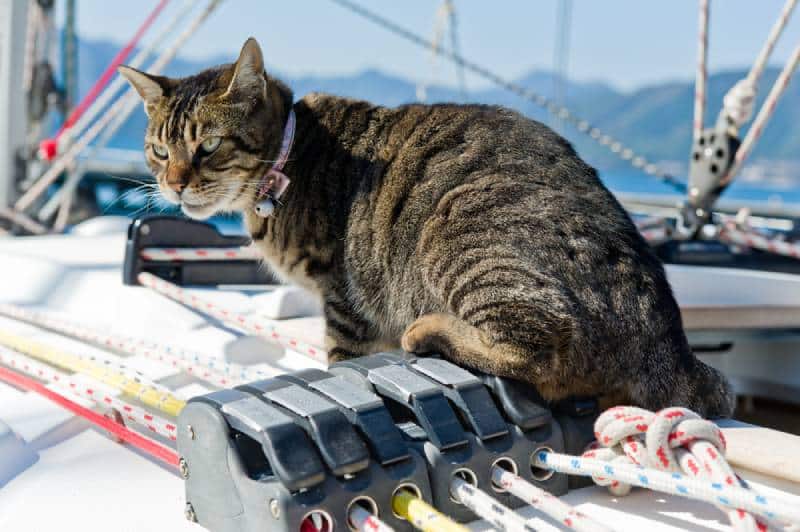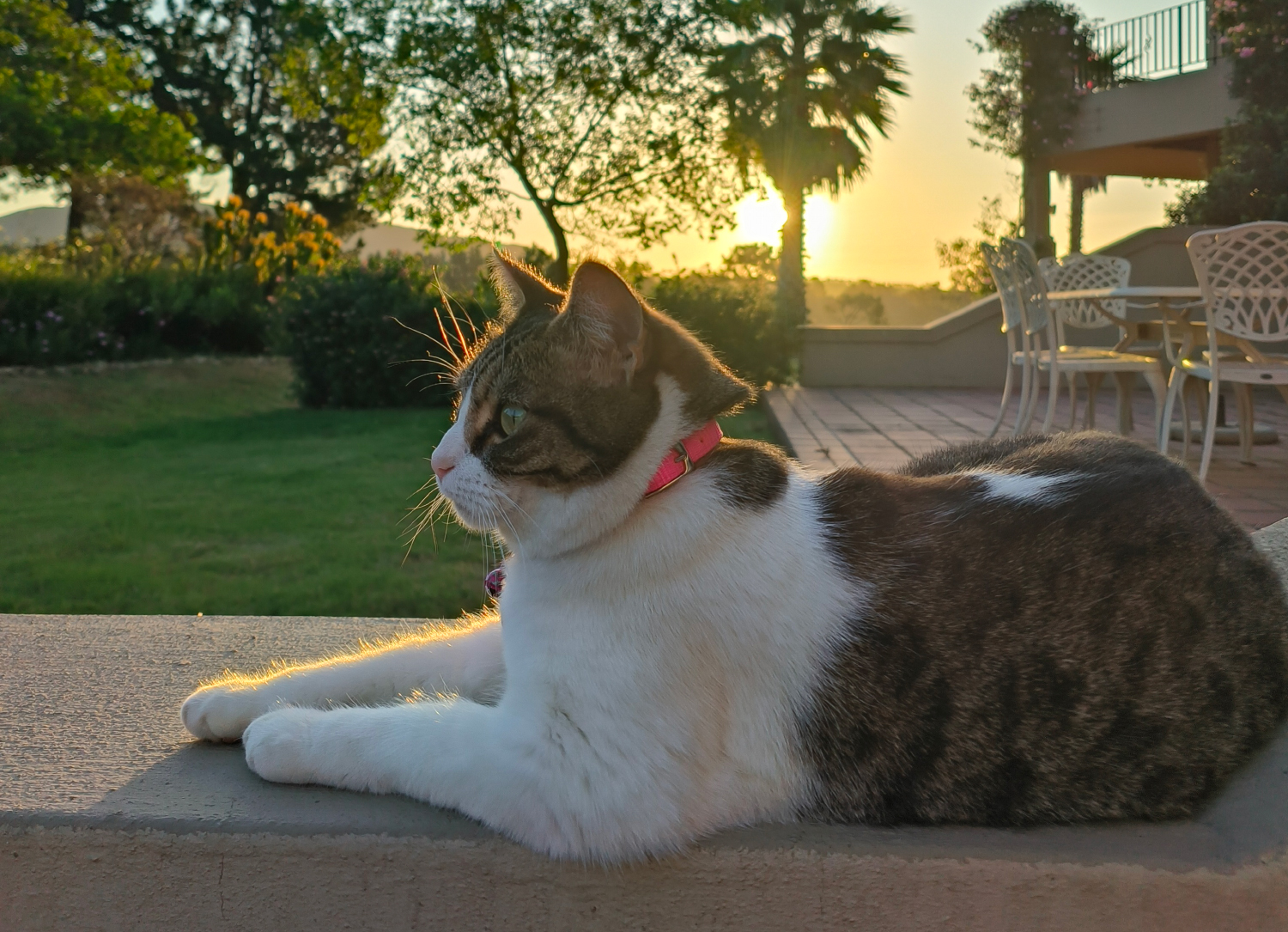Did you know cats have been traveling aboard ships for thousands of years? Cats are no strangers to the sea; even ancient Egyptian tomb paintings dating back 5,000 years depict cats hunting from ships.
When one thinks of service animals, cats are not typically what comes to mind; however, cats have been known to travel on battleships as crew members. Before that, Spanish, French, and British explorers took seafaring cats along in the late 15th century during the discovery of the Americas.
Seafaring cats deserve to be recognized for their valued work as pest control and company for military personnel during voyages. In this post, we’ll list seven famous seafaring cats that deserve a salute.

The Top 7 Famous Seafaring Ship Cats
1. Unsinkable Sam
Unsinkable Sam was a black and white cat whose real name was Oscar. Incredibly, he survived three separate ship attacks during World War II. Oscar’s journey began aboard the German ship Bismarck. In May of 1941, the ship was attacked by the British Royal Navy and sank, leaving only 115 survivors out of the more than 2,200 crew—Oscar was one of those survivors.
British Sailors scooped Oscar up upon seeing him floating on a wooden plank and brought him aboard the HMS Cossack, a British destroyer. This ship met its end from a torpedo attack in October of the same year. Once again, Oscar survived the attack.
After the HMS Cossack, Oscar was transported to the aircraft carrier HMS Ark Royal, which ultimately sank in November of 1941 after being attacked. Once again, Oscar clung to a piece of wreckage and was rescued by the British Royal Navy.
Having survived three ship attacks, Oscar lived the remainder of his life on land, hunting mice in Gibraltar for government offices. He passed away in Belfast in 1955, where he lived with a sailor.
2. Blackie
The HMS Prince of Wales also had a cat named Blackie. Blackie was primarily black with a bit of white on his front paws and white on his hind legs. In August of 1941, the ship was dispatched to carry Prime Minister Winston Churchill to Newfoundland to meet with Franklin D. Roosevelt to discuss war strategies to allow American aid to reach England during World War II. Before Winston Churchill departed the ship to meet with FDR, Blackie approached him as if to relieve his worries, if just for a moment—it was as if he knew the war heavily burdened the prime minister.
Being a cat lover, Winston Churchill bent down to pet the feline, which ultimately put Blackie in the celebrity spotlight after an iconic photo captured the moment. After the friendly encounter, Blackie’s name was changed to Churchill.
3. Convoy
Convoy was a cat that lived onboard a light cruiser called the HMS Hermione during World War II. The HMS Hermione belonged to the Royal Navy and had the dangerous duty of protecting unarmed or lightly armed ships from enemies in U-boats, enemy surface raiders, and air attacks. The cat was named Convoy by his shipmates due to the many convoy escort duties the ships made, which the cat was onboard for.
Convey was registered in the ship’s books as a Ship’s Cat and even had his own “kit.” Sailors were given a kit with certain necessities, such as shipboard clothing, hammocks, gear during inclement weather, etc.
Convoy’s kit included his very own hammock, which he slept comfortably in. Sadly, Convoy was killed along with 87 crew members in the Mediterranean Sea after an enemy attack in June of 1942.
4. Simon
Before being brought aboard the HMS Amethyst, Simon the cat lived out his days hunting rats and mice in a Hong Kong port. George Hickinbottom, a seaman onboard the HMS Amethyst, took the malnourished cat, where he was nourished back to health onboard the ship. Simon continued his expert rat hunting onboard the vessel and became well-loved by his fellow shipmates.
In 1949, the ship engaged in a gun battle with the People’s Liberation Army, now known as the Yangtze Incident. The commanding officer was killed, and Simon was badly injured; however, he survived and recovered. Unfortunately, upon returning to England, Simon was forced to undergo quarantine, where he became ill and ultimately died of infection due to his wounds.
Simon’s survival story of the Yangtze Incident became known to the world, and he became a celebrity. He was awarded the Dickin Medal and a Blue Cross and Campaign Ribbon. He was buried with honors at Ilford Animal Cemetery in London.
5. Chippy
Mrs. Chippy was a tiger-striped tabby who was owned by Harry “Chippy” McNish, a Scottish carpenter. Chippy McNish was chosen to be part of the crew onboard the ship Endurance that was used in Ernest Shackleton’s Imperial Trans-Artic Expedition, at which he brought his beloved feline onboard with him. After a month sailing the Antarctic Sea, it was discovered that Mrs. Chippy was a male, but the name had already stuck.
Mrs. Chippy proved to have extraordinary sea legs and could walk along inch-wide railings during rough seas. He befriended the entire Endurance crew with his intelligence and affectionate nature, providing company for the men—the crew even wrote about him in diaries and logs.
One such entry described a night in 1914 when Mrs. Chippy jumped overboard. The officer on watch heard her screams and the ship returned to pick him up. Woefully, Shackleton ordered Mrs. Chippy to be shot along with other “weak” animals on board after the ship became trapped in packed ice in 1915.
A new plan was implemented, and Shackelton felt the weak animals could not survive the new journey, and he deemed Mrs. Chippy as such. McNish never forgave Shackelton for killing his cat.
6. Pooli
Pooli (short for Princess Papule) was an American cat born in Pearl Harbor on July 4th, 1944. She was a ship’s cat with her own uniform aboard the USS Fremont, a command ship in the Pacific during World War II. A crewman named James Lynch brought Pooli aboard, where she witnessed intense fighting, including the invasions of Palau, Leyte, Saipan, and Iwo Jima.
When battle stations rang out, Pooli would head for the mail room, where she would curl up in a mail sack until the ship returned to normalcy. In a panic, she was almost thrown overboard by the crew for fear of being quarantined due to her presence. Pooli was guarded around the clock for three days, and the ship was docked successfully without her being discovered.
Pooli was awarded four battle stars and three campaign service ribbons for her service during the war. After the war, she lived her remaining days in quiet retirement; she even posed for a photo in 1959 in her old uniform for the Los Angeles Times.
7. Felix
Felix was the ship’s cat aboard the Mayflower II, a replica of the original Mayflower. The Mayflower II was built in the 1950s and was used to bring English residents to New England. Felix was designated the ship’s cat by the captain upon preparing to sail from Devon, England, to Plymouth, Massachusetts, in 1957. Felix even had his own gear, including a lifejacket, which he hated but wore dutifully.
Felix was known as a good sailor and rope climber, and his popularity earned him a story in Yankee Magazine. He was also featured in National Geographic and had a photo spread in Life Magazine. His popularity also inspired a children’s book called Felix and his Mayflower II Adventures.
Felix would have had to undergo quarantine to be allowed entry back into England after the voyage, and his human companion did not want to subject him to it. Instead, he lived the rest of his life in America with his new owner, Ann Barry.

Conclusion
Cats are amazing creatures, and there have been some felines that have made history during wartime. Crew members aboard these vessels were under stress and uncertainty, and the ship cats made excellent company during stressful times. The cats also earned their keep by controlling the pest population onboard. Today, take a moment to salute these brave felines and remember them for the heroes they were.
Featured Image Credit: Nikiforov Alexander, Shutterstock









